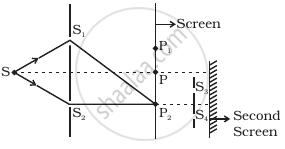Advertisements
Advertisements
Question
The refractive indices of water and diamond are `4/3` and 2.42 respectively. Find the speed of light in water and diamond. (c = 3x108 m/s)
Solution
`""^amu_w = 4/3`
`""^amu_d =2.42`
`""^amu_w = 4/3 = V_a/V_w`
`:. V_w = (3 xx10^8)/(4/3) = 3 xx 10^8 xx 3/4 = 2.25 xx 10^8` m/c
`""^amu_d = 2.42 = V_a/V_d = (3xx10^8)/V_d`
`V_d = (3xx10^8)/2.42 = 1.23 xx 10^8` m/s
APPEARS IN
RELATED QUESTIONS
Using Huygens's construction of secondary wavelets explain how a diffraction pattern is obtained on a screen due to a narrow slit on which a monochromatic beam of light is incident normally.
Explain the construction of plane wavefront using Huygens’ principle.
What is the shape of the wavefront in the following case?
Light emerging out of a convex lens when a point source is placed at its focus.
State Huygen's principle.
Consider a plane wave front incident on a thin convex lens. Draw a proper diagram to show how the incident wave front traverses through the lens and after refraction focusses on the focal point of the lens, giving the shape of the emergent wave front.
Use Huygens' principle to verify the laws of refraction.
Using Huygens’ principle, verify the laws of reflection at a plane surface.
Using this principle draw a diagram to show how a plane wave front incident at the interface of the two media gets refracted when it propagates from a rarer to a denser medium. Hence verify Snell's law of refraction.
State Huygens’s principle. Show, with the help of a suitable diagram, how this principle is used to obtain the diffraction pattern by a single slit.
Draw a plot of intensity distribution and explain clearly why the secondary maxima becomes weaker with increasing order (n) of the secondary maxima.
Derive the law of reflection using Huygen’s Wave Theory.
Define the term wavefront. Using Huygen’s wave theory, verify the law of reflection.
According to Huygens principle, ______.
What is the geometrical shape of the wavefront for:
- Light diverging from a point source?
- The pattern of wavefront of the light from a distant star intercepted by earth?
What is the phase difference between any two points lying on the same?
The inverse square law of intensity is valid for a
Figure shows a standard two slit arrangement with slits S1, S2, P1, P2 are the two minima points on either side of P (Figure). At P2 on the screen, there is a hole and behind P2 is a second 2-slit arrangement with slits S3, S4 and a second screen behind them.

For light diverging from a point source ______.
- the wavefront is spherical.
- the intensity decreases in proportion to the distance squared.
- the wavefront is parabolic.
- the intensity at the wavefront does not depend on the distance.
Is Huygen’s principle valid for longitudinal sound waves?
Consider a point at the focal point of a convergent lens. Another convergent lens of short focal length is placed on the other side. What is the nature of the wavefronts emerging from the final image?
How is a wavefront different from a ray?
Using Huygen's wave theory of light, show that the angle of incidence is equal to the angle of reflection. Draw a neat and labelled diagram.
What type of wavefronts are associated with a point source of light?
Represent diagrammatically how the incident planar wavefronts of wavelength λ pass through an aperture of size d, when d is approximately equal to λ.
Represent diagrammatically how the incident planar wavefronts of wavelength λ pass through an aperture of size d, when d is approximately equal to λ.
